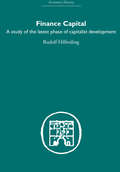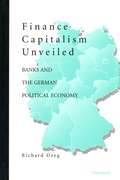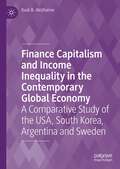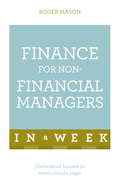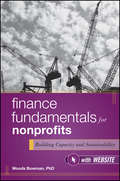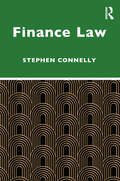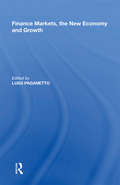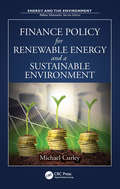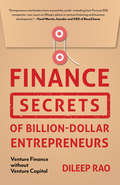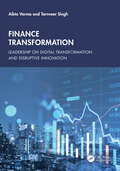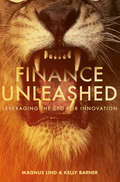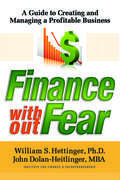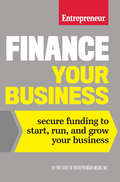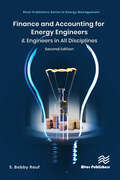- Table View
- List View
Finance Capital: A study in the latest phase of capitalist development
by Rudolph HiferdingThis is the first English translation of one of the classical works of Marxist economic theory. When Rudolf Hilferding’s Finance Capital was first published in 1919 it was acclaimed by reviewers as a continuation of Marx’s Capital, and it has a major influence upon subsequent Marxist thought, especially in the analysis of imperialism where it provided some of the fundamental ideas for the theories of Bukharin and Lenin. But Hilferding’s work was much more than a study of imperialism, which was presented only in the last section of the book. It set out to examine the main tendencies in the development of the capitalist mode of production as a whole at the beginning of the twentieth century, beginning with an exposition of the theory of money (in which particular attention was paid to the growth of credit money), then analysing the increasingly important role of the banks in the mobilization of capital, along with the development of large corporations, cartels and trusts, and finally outlining a theory of economic crises. Hilferding’s book has, however, more than an historical interest. It is a model for any renewed attempt to understand the ‘latest phase of capitalist development’ in the closing decades of the twentieth century, and Hilferdin’s ideas still provide essential elements for the elaboration of theoretically enlightened and realistic policies in the socialist movement.
Finance Capitalism Unveiled: Banks and the German Political Economy
by Richard DeegIf we are moving toward one global financial market, will all national financial systems that determine how businesses raise money look the same? Richard Deeg argues that, despite financial market integration and considerable harmonization in the regulation of financial markets, the traditional structure and economic functions of national financial systems are not inevitably undermined. Using the case of Germany--a country with a strong and distinctive financial sector that is at the center of the pressures of economic integration--the author shows how the unique aspects of the German financial sector and its relationship to the German economy have persisted notwithstanding powerful pressures to change. Posing the German model of coordinated capitalism in which banks play an important role in shaping both firm behavior and the possibilities for state intervention in the economy against the liberal model of the United States and Britain in which the securities markets play a much greater role than banks, Deeg shows how the German model has survived competitive pressures in the international economic system that have pushed Germany--and other countries--toward the liberal model. This book will appeal to political scientists and economists interested in international financial markets, globalization, and the comparative study of domestic financial markets, as well as in German politics and the German economy. Richard Deeg is Assistant Professor of Political Science, Temple University.
Finance Capitalism and Income Inequality in the Contemporary Global Economy: A Comparative Study of the USA, South Korea, Argentina and Sweden
by Kuat B. AkizhanovThis book explores the causes of rising income inequality within industrialised, developing, and emerging economies. The development of finance capitalism over the last 40 years is charted to highlight how the neoliberal restructuring of national and global economies has driven income inequality. With case studies from the USA, South Korea, Argentina, and Sweden, a comparative analysis is presented to reveal how financialisation facilitates uneven capital accumulation and generates conditions that increase income inequality.This book aims to outline an analytical framework for a financialisation-induced income inequality nexus. It will be relevant to students and researchers interested in the political economy and financial economics.
Finance Ethics: Critical Issues in Theory and Practice (Robert W. Kolb Series #11)
by John R. BoatrightA groundbreaking exploration of the critical ethical issues in financial theory and practice Compiled by volume editor John Boatright, Finance Ethics consists of contributions from scholars from many different finance disciplines. It covers key issues in financial markets, financial services, financial management, and finance theory, and includes chapters on market regulation, due diligence, reputational risk, insider trading, derivative contracts, hedge funds, mutual and pension funds, insurance, socially responsible investing, microfinance, earnings management, risk management, bankruptcy, executive compensation, hostile takeovers, and boards of directors. Special attention is given to fairness in markets and the delivery of financial services, and to the duties of fiduciaries and agents Rigorous analysis of the topics covered provides essential information and practical guidance for practitioners in finance as well as for students and academics with an interest in finance ethics Ethics in Finance skillfully explains the need for ethics in the personal conduct of finance professionals and the operation of financial markets and institutions.
Finance For Non-Financial Managers In A Week: Understand Finance In Seven Simple Steps
by Roger MasonThe ability to understand finance is crucial to anyone who wants to advance their career. Written by Roger Mason, a leading expert on business finance as both a coach and a practitioner, this book quickly teaches you the insider secrets you need to know to in order become confident with financial issues.The highly motivational 'in a week' structure of the book provides seven straightforward chapters explaining the key points, and at the end there are optional questions to ensure you have taken it all in. There are also cartoons and diagrams throughout, to help make this book a more enjoyable and effective learning experience.So what are you waiting for? Let this book put you on the fast track to success!
Finance For Non-Financial Managers In A Week: Understand Finance In Seven Simple Steps
by Roger Mason Roger Mason LtdFinance For Non-Financial Managers In A Week is a simple and straightforward training course in finance, giving you everything you need to know in just seven short chapters. From the profit statement and the balance sheet through to costing and budgets, it will help you deal confidently with questions such as 'What is the return on investment?', 'Do we have the resources?' and 'What are the cash implications?' You'll also find exercises to help you put it all into action.This book introduces you to the main themes and ideas finance and accounting, giving you a basic knowledge and understanding of the key concepts, together with practical and thought-provoking exercises. Whether you choose to read it in a week or in a single sitting, Finance For Non-Financial Managers In A Week is your fastest route to success:- Sunday: An introduction to the profit statement- Monday: An introduction to the balance sheet- Tuesday: Understanding published accounts- Wednesday: Accounting ratios and investment decisions- Thursday: Cash and the management of working capital- Friday: Costing- Saturday: BudgetsABOUT THE SERIESIn A Week books are for managers, leaders, and business executives who want to succeed at work. From negotiating and content marketing to finance and social media, the In A Week series covers the business topics that really matter and that will help you make a difference today. Written in straightforward English, each book is structured as a seven-day course so that with just a little work each day, you will quickly master the subject. In a fast-changing world, this series enables readers not just to get up to speed, but to get ahead.
Finance Fundamentals for Nonprofits
by Woods BowmanA complete guide to the financial requirements a nonprofit organization must follow to indefinitely maintain the volume and quality of their servicesAn organization may have plenty of capacity in the long run, but in the short run, donor restrictions and limited financing options are constraining. Here-and-now liquid assets are the only resources available. Finance Fundamentals for Nonprofits: Building Capacity and Sustainability shows how to measure a nonprofit organization's financial capacity in different time frames and how to measure its ability to sustain capacity in each case.Explains how nonprofits differ from businesses and how they promote values-centered managementReveals how to improve financial capacity and sustainability Written by a nonprofit scholarFilled with real-world case studies and actionable advice relating financial health to financial capacity and sustainability, this book is essential reading for every nonprofit professional.
Finance Law
by Stephen ConnellyFor the student who wishes to understand law as it is practised in a modern financial context, Finance Law offers the only up-to-date university-level textbook which explains legal principles as they are applied in today’s advanced financial transactions.Essential for any student or researcher seeking an introduction to this complex and fast-moving world, this text: is based on the author’s extensive teaching experience in finance law covers the modern form of credit facilities agreements, security, syndication, securities and securitization, derivatives, and payment and clearing systems is packed with interesting case studies, including the Mozambique Tuna Bond Scandal, the takeover of Manchester Utd plc, and the securitization of student loans motivates study with theoretical discussions and historical contextualisation explains key transaction structures, such as investment grade lending to groups, intercreditor agreements, interest rate swaps, and multilateral payment systems grants insight into key legal principles and structuring applicable to trillion dollar deals across the globe is written by a structured finance practitioner and academic with extensive post-qualification experience of advising lenders, corporate borrowers and sovereigns on international finance Designed for final-year undergraduates and LLM students, Finance Law is not only the perfect accompaniment to any finance module, but can support any advanced programme on insolvency law, mergers and acquisitions (M&A), corporate governance, international economic law and more.
Finance Markets, the New Economy and Growth
by Luigi PaganettoThe existence of significant differences in the organization of the US and European financial markets prompts a number of important questions. Firstly, is it possible to determine the type of institutions that are more conducive to growth? Secondly, did the financial markets play a key role in securing the growth and prosperity of the US during the 1990s? A third issue is the effect of the recent changes in the organization of the financial markets. The last issue addressed relates to the effects on investment and growth of the different corporate governance structures that prevail in the various countries. By exploring the differences between the financial markets in the US and Europe this book helps the reader assess the role of financial markets in securing investment and growth.
Finance Policy for Renewable Energy and a Sustainable Environment (ISSN)
by Michael CurleyThis book explains how environmental projects and improvements are achieved through the imposition of regulations, on the one hand, and financial incentives on the other. It discusses how those incentives can be organized to achieve the greatest environmental benefits at the lowest possible cost to the public. It presents the best environmental finance policies for the financing of alternative energy projects so that the ultimate cost of delivered power will decline. It also examines the challenges of the next generation of environmental programs.
Finance Reading: Capital Structure Theory
by Timothy A. LuehrmanThis reading introduces students to the theory of capital structure. It explores the determinants of an optimal capital structure-first in the context of Modigliani and Miller's (M&M's) perfect market conditions, and then as M&M conditions are selectively relaxed. The reading begins with an overview and comparison of the distinctive characteristics of debt and equity securities and why the choice between them is relevant. The effects of leverage on measures of company financial performance and on the allocation of risk between debt and equity holders follows, laying the groundwork for a discussion of capital structure choice that is initially cast in terms of selecting a target leverage ratio. Next, the M&M propositions are introduced and readers learn why, under perfect market conditions, financing decisions are irrelevant to firm value. Numerical examples and an interactive illustration are used to illustrate the propositions. The M&M conditions are then relaxed to include taxes, financial distress, agency costs, asymmetric information, etc. Alternative theories of optimal capital structure-including the static tradeoff model and pecking order theory-are developed and compared. The Supplemental Reading covers the difficulties of resetting capital structure once firms are overleveraged and also provides some real-world context for how corporate managers make capital structure decisions.
Finance Reading: Cost of Capital
by Timothy A. LuehrmanThis Reading introduces students to practical problems they will encounter when estimating and applying the cost of capital in a DCF valuation. It applies, but does not derive, key ideas from modern portfolio theory and is accessible to students who have not yet studied portfolio theory. The reading begins by defining the cost of capital narrowly, as a discount rate (in a DCF valuation) that must equal the opportunity cost of funds, or equivalently, the sum of the time value of money and a risk premium. This intuitive explanation is followed by the CAPM equation, and practical discussions of systematic risk, beta, and the equity market risk premium. The Reading then introduces WACC as an alternative calculation for the cost of capital and shows, graphically and mathematically, the correspondence between CAPM and WACC in the absence of taxes. The Reading also explains that the "(1-t)" adjustment term in the formula for WACC with taxes compensates for missing interest tax shields in the standard calculation of Free Cash Flow. The next section is a step-by-step explanation of how to calculate WACC for a real company, including discussions of data and sources commonly used by practitioners to compute leverage ratios, the cost of debt, the tax rate, the risk-free rate, and so forth. Finally, the reading takes the student through an illustrative calculation of WACC for Coca-Cola, as of December 31, 2015, using data from Coca-Cola's SEC filings and the capital markets. The Supplemental Reading section examines some of the limitations of WACC as a discount rate as well as some common errors that practitioners make in computing and using WACC. It also covers two alternatives to WACC-based DCF, the APV and CCF methods.
Finance Reading: Financial Options and Their Application to Corporate Finance
by E. Scott MayfieldThis reading provides a solid foundation and consistent knowledge base for understanding the key insights from options theory. It begins by developing terminology and a framework for understanding the contractual rights and obligations embedded in financial option contracts. The framework is used to map out the future cash flows (payoffs) associated with specific types of option contracts. Using the associated payoff functions, the value of an option contract is motivated as the present value of the option's expected future payoffs and is derived as the value of the portfolio of securities that would replicate those payoffs. The reading then examines how option contracts can be combined to provide specific desired payoffs (hedging). The reading shows how the Black-Scholes formula extends the framework. Discussion of the model includes intuition, insights about parameters, and numeric examples. Finally, several corporate finance applications are discussed, including accounting for the cost of employee stock option grants, understanding and valuing contractual terms of an acquisition offer, and determining an appropriate yield-to-maturity on new corporate debt issue.
Finance Reading: Introduction to Bonds and Bond Math
by Timothy A. LuehrmanThis reading covers the basic elements of bonds and introduces some of the analytical techniques used to understand and compare them. It assumes the reader is familiar with the concept of the time value of money (see HBP 8299). The reading provides an economic analysis of simple risk-free bonds, including both zero-coupon and coupon bonds, and extends to bonds with credit risk. The material covers the relationships between prices, yields and maturity and introduces the concept of duration. The reader is introduced to the yield curve and the term structure of interest rates. Selected advanced topics (floating rate bonds, forward rates, evaluating default risk) are included in the Supplemental Reading. The reading concludes with a brief discussion of how the formulas in the reading relate to pre-programmed Excel functions. The reading includes nine interactive illustrations: "Bond Terminology" is a term sheet excerpted from an Apple, Inc. prospectus which familiarizes the reader with bond terminology. "Calculating the Price of a Coupon Bond" calculates the price (present value) of a bond's cash flows, based on reader inputs for maturity, coupon and yield to maturity (YTM). "Inverse Relationship Between Bond Price and Yield to Maturity" demonstrates the inverse relationship between prices and yields. "Historical Yield Curves" is an animated display of the U.S. Treasury yield curve from 1962 to 2015. "Bond Duration" calculates the duration of a bond based upon inputs for maturity, coupon and YTM. "Bond Duration and Maturity" demonstrates the relationship between duration and maturity over a 50-year horizon. "Calculating Bond Duration" is an animated demonstration of how duration is calculated. "Bond Price Sensitivity to Changes in Interest Rate" demonstrates the sensitivity of bond duration to changes in interest rates and maturity.
Finance Reading: NPV and Capital Budgeting
by Timothy A. LuehrmanThis reading introduces students to the capital allocation process. It presents the valuation tools and financial metrics used by companies to evaluate investment opportunities. The reading begins with the relatively simple problem of evaluating a single investment proposal using net present value (NPV) and relates NPV to the concept of value maximization. It then considers alternative metrics and examines the pros and cons of each. Each metric is compared to NPV in execution and likely performance. The reading then proceeds to a more complicated problem commonly faced by managers: how to choose among multiple projects, often in the presence of budgetary or managerial constraints. Students are given a framework for comparing and ranking projects utilizing the various metrics. A brief detour links NPV to the capital markets and, specifically, to risk and expected returns. The reading concludes with an overview of real-world complications that can limit the reliability of the various financial metrics used throughout the reading, and considers ways to adapt metrics and methodologies accordingly. The reading contains seven web-based interactive illustrations. Five of these provide an application and visual representation of important tools and metrics covered in the reading, including NPV, internal rate of return, payback period, and the profitability index. Two additional interactives illustrate the complexity of making capital budgeting decisions in a complex operating environment with multiple investment opportunities. The first of these examines the implications of using a single hurdle rate to evaluate projects of varying degrees of riskiness; the latter illustrates the difficulties involved in selecting the value maximizing set of opportunities in the presence of a budget constraint and/or in situations where one or more projects monopolize the available budget.
Finance Reading: Portfolio Theory
by Timothy A. LuehrmanThis is the second in a set of two Readings on Modern Portfolio Theory. It presumes students have already read "Risk and Return 1: Stock Returns and Diversification" (#5220). This Reading starts by examining the effect of diversification on portfolio volatility, graphically and mathematically, for different levels of correlation among portfolio assets. Next, it compares portfolios and defines the concepts of efficiency and the efficient frontier. It introduces a riskless asset and uses it to identify the tangency portfolio and to define the Sharpe Ratio as a way to compare excess returns to risk. The discussion demonstrates how borrowing and lending can create any portfolio along the line between the risk-free rate and a portfolio in mu-sigma space, and it presents the two-fund separation theorem. Finally, the Reading considers the problem of whether to add a small amount of a risky asset to an existing portfolio as a way to derive the Portfolio Improvement Rule, before concluding with general equilibrium and the Capital Asset Pricing Model (CAPM). Topics covered in the Supplemental Reading section include estimation of betas, the equity market risk premium, and real-world application of CAPM, and criticisms of CAPM, both theoretical and practical. The Reading contains six web-based interactive illustrations. The first shows the decline in the volatility of a portfolio's returns as the number of stocks in the portfolio increases from two to 30. The second is the same as the first but allows the reader to specify the correlation among the 30 stocks. The third shows the region in mu-sigma space that includes all possible portfolios for five risky assets, the "broken eggshell" shape. The fourth shows possible portfolios composed of two assets when one of the assets is risk-free. The fifth illustrates how the tangency portfolio and Sharpe ratio are determined. The sixth illustrates the Portfolio Improvement Rule.
Finance Reading: Stock Returns and Diversification
by Timothy A. LuehrmanThis is the first in a set of two Readings on risk and return. It introduces the ideas of financial risk and return, at first intuitively, with a discussion of investor risk aversion and tradeoffs, and then formally, with a basic explanation of pertinent statistics. It introduces probability distributions and their parameters-mean and standard deviation-as measures of expected return and risk. Using sample statistics from historical returns as coordinate pairs, it plots asset classes in mu-sigma space to give a graphical representation of risk and return, and defines dominance. To cement students' understanding, the text steps through calculations of risk and return statistics from historical price data for Microsoft to mu-sigma space. The second half of the reading covers the co-movement of stock returns using sample covariance, beta, and correlation computed for pairs of risky assets. Scatter plots and linear regression are introduced to calculate beta. The Reading introduces essential portfolio math, with portfolio weights and correlation coefficients. It shows that a portfolio's risk is lower than the weighted average risk of its component assets if the assets are not perfectly positively correlated. This fundamental statistical property gives rise to the economics of diversification. The Reading contains 7 web-based Interactive Illustrations. The first demonstrates the Central Limit Theorem. The second ensures that students have a solid understanding of how returns are calculated from prices and dividends. The third shows how to create a histogram.
Finance Reading: The Mergers and Acquisitions Process
by John CoatesThis Reading introduces students to basic elements of the structure and process for mergers and acquisitions transactions, arising from markets, custom, and law. It introduces important characteristics of typical M&A transactions, such as deal structure, elements of M&A contracts, and reasons for and effects of a typical deal process. No prior knowledge or reading is necessary.
Finance Reading: Time Value of Money
by Timothy A. LuehrmanGiven an interest rate, students will learn to calculate the present value of a sum to be received in the future or, alternatively, the future value of a sum invested today. The reading covers compounding and discounting, the two types of calculations used to determine the future and present value of money. It concludes with more complicated calculations drawn from real-world examples, and a brief discussion of how the formulas in the reading relate to pre-programmed Excel functions. The reading includes eight interactive illustrations: "Time Value of $100 Cash" shows the value of $100 compounded or discounted over 1-, 2-, and 3-year periods; "Calculating the Present Value of Multiple Cash Flows" is an animated presentation of present value calculations involving multiple (equal) cash flows and multiple periods; "Present or Future Value of Multiple Cash Flows" covers multiple (equal) cash flows and multiple periods, and allows students to choose whether to compute present values or future values and observe the results; "Time Value of $100 with Compounding Frequencies" allows the reader to observe the impact of varying the interest rate and compounding frequency on the present or future value of $100; "Effect of Compounding Frequency" visually illustrates the economic impact of compounding frequency on future value; "Mortgage as an Annuity" is a mortgage calculator which allows the reader to set the APR and mortgage term and see how each affects the monthly payment as well as the split between principal and interest over time; "Present Value of Perpetuities and Annuities by Term" illustrates the changing relationship between a perpetuity and annuities (which share the same annual payment stream but differ in their term lengths) as interest rates change; "Practice Questions for Time Value of Money" is a self-study tool which enables students to check their comprehension.
Finance Secrets of Billion-Dollar Entrepreneurs: Venture Finance without Venture Capital
by Dileep RaoThe author of Nothing Ventured, Everything Gained analyzes successful startups to show readers how to launch a successful business without outside help.Award-winning professor of entrepreneurship Dileep Rao presents readers with a detailed guide to success through his interviews and analysis of billion-dollar entrepreneurs (those who built a venture from startup to more than $1 billion in sales and valuation) and 100 million-dollar entrepreneurs (startup to $100 million).Rao is here to show entrepreneurs that it is possible to start a business without outside help. He shares how more than ninety percent of America’s billion-dollar entrepreneurs in the VC era (since 1946) avoided or delayed VC, and instead used finance-smart expertise?skills that combine business-smart, capital-smart, and leadership-smart strategies.It takes more than one person to grow a business from the bottom up. But that doesn’t mean we have to sacrifice control of the venture in the process. Armed with twenty-three years of experience as a financer, Rao shows readers how to optimize internal financing to attract external financing. By keeping control of the venture, entrepreneurs keep more of the wealth, as well.In Finance Secrets of Billion-Dollar Entrepreneurs learn about:Pre-financing, financing and post-financing skills and strategies of finance-smart entrepreneursThe ins and outs of venture finance, applicable to anyone looking to start a businessTips on increasing capital productivity and attaining financially sustainable entrepreneurshipPerfect for readers of The Lean Startup, The $100 Startup, or Venture Deals.Praise for Finance Secrets of Billion-Dollar Entrepreneurs“This book delivers clear thinking for entrepreneurs who want to control their own destiny and grow their business without the need for venture capital.” —Joel Cannon, co-founder and president of Cannon Technologies“Entrepreneurs and leaders from around the world—including from Fortune 500 companies—can count on Dileep’s advice in venture financing and business development.” —Yosef Martin, founder and CEO of BoxyCharm“With the voice of an entrepreneur, the insight of a scholar and the wisdom of experience, Rao provides a clear roadmap for how entrepreneurs can grow successful companies while maintaining control of their ventures!” —Dr. Raymond Smilor, Emeritus Professor of Entrepreneurship, Neeley School of Business, TCU“Must-read material for every business owner looking to build their empire.” —Brian Moran, CEO, Small Business Edge
Finance Transformation: Leadership on Digital Transformation and Disruptive Innovation
by Tarnveer Singh Aikta VarmaFinance Transformation: Leadership on Digital Transformation and Disruptive Innovation is a general and wide-ranging survey of finance transformation and emerging technologies. Finance and IT have long been important areas of any business, but recent technological developments are innovating and disrupting both. This book lays a path towards the benefits and away from potential risks. It covers the widest array of topics, from quantum computing to blockchain technology, from organisational culture and diversity to hybrid working, and from regulation to cybersecurity. Written by two vastly experienced industry professionals, this book includes real-life examples and up-to-date references. It will be of particular interest to business stakeholders, executives, and policymakers.
Finance Unleashed
by Magnus Lind Kelly BarnerFast moving, to the point, and rooted in first-hand executive experiences, this book is for people of vision and action, and for creating the conditions required for growth, innovation, and increased competitive advantage. Finance Unleashed is based on a series of interactive interviews with a diverse group of global influencers and executives, all of which will challenge readers to think laterally and find inspiration in the new role of finance. Cases and interviewees represent organizations such as UPS and DHL, and the London School of Economics, and approaches such as Lean Six Sigma, innovation, customer-centricity, the financial supply chain, and behavioral procurement. The authors' goal is to serve as a catalyst for leaders who are positioned to make meaningful changes today. The book includes a practical model to help executive teams redesign and refocus finance to drive business leadership - with an emphasis on the CFO. The model has three primary components: 1) Customer-Centricity - Listen and Map; 2) Process - Structure and Technology; and 3) Innovation - Create and Measure. These are presented as phases that each executive team will need to consider based on the goals and maturity level of their organization. For the CFO and ambitious finance executives, Finance Unleashed presents a path forward towards success and career advancement. For the CEO and the board, it presents an expanded vision for what financial organizations are capable of.
Finance Without Fear: A Guide to Creating and Managing a Profitable Business
by William S. Hettinger John Dolan-HeitlingerFinance Without Fear should be read by anyone starting or managing a business. The easy-to-read style helps remove the fear of finance for the entrepreneur, the small business owner, and the manager. Finance does not need to be mysterious and intimidating. Basic business finance is not hard to understand, and the business owner or manager who understands finance has a leg up on the competition. Finance Without Fear explains the key financial statements - the cash flow statement, profit and loss statement, and balance sheet - and provides the tools to analyze these financial statements. Genuine case studies of small businesses - a retail shop, small manufacturing business, and professional services office - are used throughout, so you can compare the way your business works to the case studies, and to industry norms. In the short amount of time it will take to read Finance Without Fear, you will learn the basics of finance, and the keys to creating and managing a profitable business. Finance Without Fear is available both as a book and as an e-book. The e-book versions have been custom formatted to maintain the integrity of the financial statements and other exhibits that appear throughout the book.
Finance Your Business: Secure Funding to Start, Run, and Grow Your Business
by The Staff of Entrepreneur MediaTapping into more than 33 years of small business expertise, the staff of Entrepreneur Media takes today's entrepreneurs beyond financing their idea and opening their doors to keeping the cash flow flowing and the capital coming in through the first three years of ownership. Defines funding options ranging from small business loans and angel investors to crowdfunding and venture capital. Real-world examples of funding and financing plans that work. In-the-trenches financing wisdom that help businesses stay profitable.
Finance and Accounting for Energy Engineers: & Engineers in All Disciplines (River Publishers Series in Energy Management)
by S. Bobby RaufThe purpose of this second edition is to provide an overview of important principles in the fields of finance and accounting, and the application of those principles for financial analysis of energy and non-energy capital investments. This book is written as a self-study guide for energy and non-energy engineers and managers who either lack formal training in the subjects of finance, accounting, and engineering economics, or simply need a means to refresh their knowledge in these subjects. This book bridges the gap between the typical business school "MBA" knowledge and its application in enery and non-engergy engineering, project management or manufacturing management. Many energy and non-energy engineers and technical managers feel inadequately equipped to comprehend and apply certain important finance and accounting principles. Understanding of finance and accounting principles is important in interfacing and conducting business with accountants, financial analysts, and members of upper management. This book is designed to familiarize energy engineers and other engineering professionals - in a relatively simple and easy to understand fashion - with decision making skills founded on financial calculations and case study based quantitative analysis.
